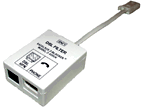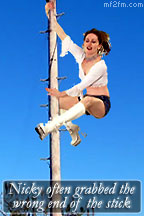Monday 19 November, 2007, 11:53 - Much Ado About Nothing
Posted by Administrator
For the past few months, every evening around sunset, my (ADSL) broadband connection at home has been 'drying up'. By this, I mean that the throughput has got smaller and smaller until eventually there has been no incoming or outcoming bandwidth available at all. If left alone, after an hour or two, the situation tends to correct itself but with sunset currently occuring during the working day, it's annoying to lose internet connectivity at these times.Posted by Administrator
At first I thought the problem might be to do with my ISP, Sky Broadband, but a quick scan of the rather useful, but unofficial, Sky User Forums didn't seem to indicate that others were suffering the same problems as me (though there were one or two veiled comments about how the connection sometimes dropped at night).
 My next thought turned to my home installation. I'm quite a way from the local exhange and as such only get a connection speed of approximately 4 Mbps downstream and more like 0.4 Mbps upstream. According to my router, the available signal to noise ratio on the downstream link is only 8dB, that is to say that the ADSL signal on my phone line is only approximately 2.5 times higher than the noise on the line which isn't a great deal. But fiddling around with filters and connections makes next to no difference and the connection remains resolutely poor. During the 'dry periods' the signal to noise falls to 3dB or less (hence the loss of the connection), but re-booting the modem at these times oddly yields a return to 8dB.
My next thought turned to my home installation. I'm quite a way from the local exhange and as such only get a connection speed of approximately 4 Mbps downstream and more like 0.4 Mbps upstream. According to my router, the available signal to noise ratio on the downstream link is only 8dB, that is to say that the ADSL signal on my phone line is only approximately 2.5 times higher than the noise on the line which isn't a great deal. But fiddling around with filters and connections makes next to no difference and the connection remains resolutely poor. During the 'dry periods' the signal to noise falls to 3dB or less (hence the loss of the connection), but re-booting the modem at these times oddly yields a return to 8dB.Being a radio engineer type, and knowing that ADSL uses radio frequencies, I began to wonder whether the problem might be to do with increased radio interference on the line around sunset. ADSL uses frequencies from approximately 26 to 138 kHz for the upstream connection (i.e. from the home to the exchange) and in the range 138 kHz to 1104 kHz for the downstream connection (from the exchange to the home), though this frequency range is extended to just over 2200 kHz for the faster ADSL2+. Given my distange from the exchange, my connection is resolutely ADSL only (and not ADSL2+) and therefore if there was an increase in interference it would need to be in the frequency range 138 to 1104 kHz. However, as most ADSL modems are capable of running ADSL2+ even if the line is not capable of supporting it, it is likely that the receivers in them are not filtering out unwanted or unused frequencies making them susceptible to interference on frequencies up to 2200 kHz and quite possibly even higher even if those frequencies are not in use.
 Now as it happens, this frequency range is home, in Europe, to both long wave and medium wave radio transmitters (in the frequency range 148.5 to 285.5 kHz and 526.5 to 1606.5 kHz respectively) and there are many high powered radio transmitters in this frequency range. Could it be that the propagation that exists around sunset causes such a significant rise in the level of signals in this frequency range that it was knocking out my ADSL connection? The telephone connections in my area are via flown cables between telegraph poles (as they are still called despite telegraph having died out eons ago) and as such probably make rather good aerials, so it is quite possible that my modem is susceptible to incoming interference from high power long and medium wave broadcast transmitters.
Now as it happens, this frequency range is home, in Europe, to both long wave and medium wave radio transmitters (in the frequency range 148.5 to 285.5 kHz and 526.5 to 1606.5 kHz respectively) and there are many high powered radio transmitters in this frequency range. Could it be that the propagation that exists around sunset causes such a significant rise in the level of signals in this frequency range that it was knocking out my ADSL connection? The telephone connections in my area are via flown cables between telegraph poles (as they are still called despite telegraph having died out eons ago) and as such probably make rather good aerials, so it is quite possible that my modem is susceptible to incoming interference from high power long and medium wave broadcast transmitters. When first booted up, the ADSL modems at both the exchange and the home end 'train', that is to say that they check all the available frequencies to see which have the best signal to noise and then use just these frequencies for the connection. This would perhaps explain why re-booting the modem during a dry period restores the signal to noise: clearly the frequency on which the interference occurs is one which is clean in the mornings when the modem is first switched on.
 As yet I have not been able to confirm my theory that interference from high power broadcast transmitters is knocking out my broadband connection, but it does seem eminently reasonable. Next steps are to do some tests (maybe connect a receiver to the phone line - bearing in mind it has 50 Volts on it!) Another option might be to add some filtering to the incoming line: surprisingly ADSL microfilters do not touch the ADSL frequency range they just stop the ADSL signal getting into/out of any phones connected (see the example circuit diagram on the right), which means, incidentally, that if you have nothing other than an ADSL modem connected to any phone socket in your house, you don't need a microfilter on it: you only need microfilters on the sockets where phones are connected. Perhaps, therefore, there's room for an improved microfilter that cleans up the incoming ADSL connection as well as keeping it out of the phones. I'll keep you informed of any progress - and if you experience these problems yourself leave a comment and I'll update you personally if I make any breakthroughs!
As yet I have not been able to confirm my theory that interference from high power broadcast transmitters is knocking out my broadband connection, but it does seem eminently reasonable. Next steps are to do some tests (maybe connect a receiver to the phone line - bearing in mind it has 50 Volts on it!) Another option might be to add some filtering to the incoming line: surprisingly ADSL microfilters do not touch the ADSL frequency range they just stop the ADSL signal getting into/out of any phones connected (see the example circuit diagram on the right), which means, incidentally, that if you have nothing other than an ADSL modem connected to any phone socket in your house, you don't need a microfilter on it: you only need microfilters on the sockets where phones are connected. Perhaps, therefore, there's room for an improved microfilter that cleans up the incoming ADSL connection as well as keeping it out of the phones. I'll keep you informed of any progress - and if you experience these problems yourself leave a comment and I'll update you personally if I make any breakthroughs!Update: 18 Dec 2007 Forcing the modem to use ADSL instead of ADSL2+ whilst reducing the connection speed by less than about 5% has almost eradicated the problem. It seems that purposefully avoiding the use of frequencies above 1.1 MHz does make a worthwhile difference.
Update: 11 Feb 2012 After much messing about Wireless Waffle has designed a filter which cures the ADSL drop-out problem that is described above. It costs next to nothing and can be made in minutes!
14 comments
( 6223 views )
| permalink
| 



 ( 2.8 / 49546 )
( 2.8 / 49546 )




 ( 2.8 / 49546 )
( 2.8 / 49546 )

